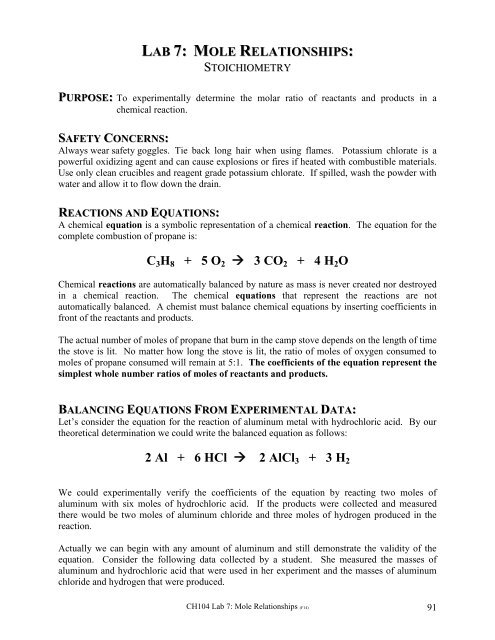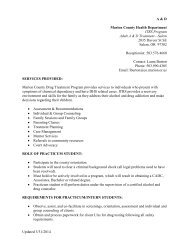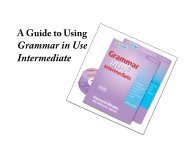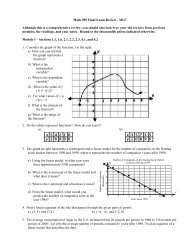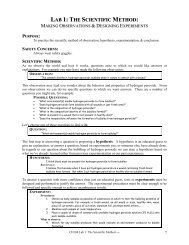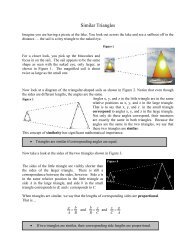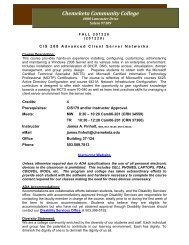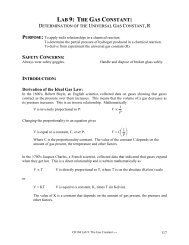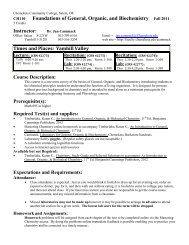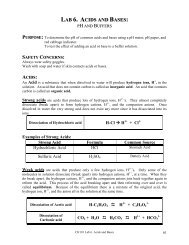7 Mole Relationships - Faculty.chemeketa.edu
7 Mole Relationships - Faculty.chemeketa.edu
7 Mole Relationships - Faculty.chemeketa.edu
Create successful ePaper yourself
Turn your PDF publications into a flip-book with our unique Google optimized e-Paper software.
LAB 7: MOLE RELATIONSHIPS:STOICHIOMETRYPURPOSE: To experimentally determine the molar ratio of reactants and products in achemical reaction.SAFETY CONCERNS:Always wear safety goggles. Tie back long hair when using flames. Potassium chlorate is apowerful oxidizing agent and can cause explosions or fires if heated with combustible materials.Use only clean crucibles and reagent grade potassium chlorate. If spilled, wash the powder withwater and allow it to flow down the drain.REACTIONS AND EQUATIONS:A chemical equation is a symbolic representation of a chemical reaction. The equation for thecomplete combustion of propane is:C 3 H 8 + 5 O 2 3 CO 2 + 4 H 2 OChemical reactions are automatically balanced by nature as mass is never created nor destroyedin a chemical reaction. The chemical equations that represent the reactions are notautomatically balanced. A chemist must balance chemical equations by inserting coefficients infront of the reactants and products.The actual number of moles of propane that burn in the camp stove depends on the length of timethe stove is lit. No matter how long the stove is lit, the ratio of moles of oxygen consumed tomoles of propane consumed will remain at 5:1. The coefficients of the equation represent thesimplest whole number ratios of moles of reactants and products.BALANCING EQUATIONS FROM EXPERIMENTAL DATA:Let’s consider the equation for the reaction of aluminum metal with hydrochloric acid. By ourtheoretical determination we could write the balanced equation as follows:2 Al + 6 HCl 2 AlCl 3 + 3 H 2We could experimentally verify the coefficients of the equation by reacting two moles ofaluminum with six moles of hydrochloric acid. If the products were collected and measuredthere would be two moles of aluminum chloride and three moles of hydrogen produced in thereaction.Actually we can begin with any amount of aluminum and still demonstrate the validity of theequation. Consider the following data collected by a student. She measured the masses ofaluminum and hydrochloric acid that were used in her experiment and the masses of aluminumchloride and hydrogen that were produced.CH104 Lab 7: <strong>Mole</strong> <strong>Relationships</strong> (F14) 91
Grams used orproducedAl + HCl AlCl 3 + H 2103 g 416 g 507 g 11.5 gMass of reactants = 103 g + 416 g= 519 gMass of products = 507 g + 11.5 g= 518.5 gNotice the masses of the reactants and products. The Law of Conservation of Mass states that ina chemical reaction, the total mass of the reactants equals the total mass of the products.Since experimental measurements are never exact, small differences in the masses occur but arenot significant.Let's see how the experimental data verifies the validity of the balanced equation.Step 1: Calculate the number of moles of each substance. The formula weight ofa substance can be found by adding the atomic weights of every atom in the formula.Al + HCl AlCl 3 + H 2Grams used 103 g 416 g 507 g 11.5 gor producedFormula Weights 26.98 amu 1.01 + 35.45 =36.46 amu26.98 + 3(35.45)= 133.33 amu2 (1.01)= 2.02 amuThe mass of 1 mole of a substance is equal to the formula weight expressed in units of grams.The mass of one mole (the molar mass) can be used as a conversion factor.Al + HCl AlCl 3 + H 2Grams used 103 g 416 g 507 g 11.5 gor producedFormula Weights 26.98 amu 1.01 + 35.45 =36.46 amu26.98 + 3(35.45)= 133.33 amu2 (1.01)= 2.02 amu<strong>Mole</strong>s usedor produced103gAl (1molAl) =1 (26.98gAl)= 3.82 mol Al416gHCl (1molHCl) =1 (36.98gHCl)= 11.4 mol HCl507gAlCl 3 (1mol AlCl 3)=1 (133.33g AlCl 3)= 3.80 mol AlCl 311.5gH 2 (1mol H 2 ) =1 (2.02g H 2 )= 5.69 mol H 2The coefficients of an equation represent the number of moles of each substance. Therefore wemight try to write the equation for the reaction as:3.82 Al + 11.4 HCl → 3.80 AlCl 3 + 5.69 H 2This is incorrectly written since the coefficients must be the smallest whole number molarratios of the substances.92CH104 Lab 7: <strong>Mole</strong> <strong>Relationships</strong> (F14)
Step 2: Find the molar ratios. To find the ratios of moles of the reactants and products,divide each number by the smallest number. The smallest number is 3.80.Al + HCl AlCl 3 + H 2Grams used103 g 416 g 507 g 11.5 gor producedFormula Weights 26.98 amu 1.01 + 35.45 =36.46 amu26.98 + 3(35.45)= 133.33 amu2 (1.01)= 2.02 amu<strong>Mole</strong>s used 3.82 mol Al 11.4 mol HCl 3.80 mol AlCl 3 5.69 mol H 2or producedMolar Ratios 3.82 = 1.013.8011.4 = 3.003.803.80 = 1.003.805.69 = 1.503.80We could use the molar ratios to write the equation as:1.01 Al + 3.00 HCl 1.00 AlCl 3 + 1.50 H 2This is still incorrect since the coefficients of the equation must be the smallest whole numberratios. The coefficient 1.01 Al is very close to a whole number but the coefficient 1.50 H 2 is notclose to a whole number.Step 3: Find the whole number molar ratios. If the molar ratios are not wholenumbers, double every coefficient to obtain whole numbers.Grams usedor producedFormula WeightsAl + HCl AlCl 3 + H 2103 g 416 g 507 g 11.5 g26.98 _g_mol<strong>Mole</strong>s usedor producedMolar Ratios 3.82 = 1.01Whole numbermolar ratios1.01 + 35.45 = 36.46 _g_mol26.98 + 3(35.45)= 133.33 _g_mol2 (1.01)= 2.02 _g_mol3.82 mol Al 11.4 mol HCl 3.80 mol AlCl 3 5.69 mol H 211.4 = 3.003.80 = 1.005.69 = 1.503.80 3.803.803.802.02 2 6.00 6 2.00 2 3.00 3These whole number molar ratios are based on experimental data. Since measurements are neverexact, the calculated whole numbers are not exactly whole numbers. We have to round off 2.02to 2 and use it as the coefficient of hydrogen.The whole number molar ratios are the coefficients of the balanced equation!2 Al + 6 HCl 2 AlCl 3 + 3 H 2Two moles of aluminum react with six moles of hydrochloric acid to produce two moles ofaluminum chloride and three moles of hydrogen. We have experimentally determined thecoefficients of the equation by measuring the masses of each reactant and product.CH104 Lab 7: <strong>Mole</strong> <strong>Relationships</strong> (F14) 93
DECOMPOSITION OF POTASSIUM CHLORATEThe reaction you will study is the decomposition of potassium chlorate (KClO 3 ). Potassiumchlorate is a white solid that is used as a source of oxygen in explosives and fireworks. Whenpotassium chlorate is heated to a temperature greater than 356°C, it decomposes into potassiumchloride and elemental oxygen according to the following unbalanced equation:_____KClO 3 _____KCl + _____O 2You will heat a weighed sample of potassium chlorate in a crucible until the oxygen is drivenoff. The residue left in the crucible will be potassium chloride--you will measure its mass.There is no direct way to measure the mass of the oxygen gas since it will escape into the air. Ifthe crucible and its contents lose mass during heating, the mass lost must be equal to the mass ofthe oxygen.All weighing must be done at room temperature; a hot crucible weighs less than a roomtemperature crucible just as a hot air balloon weigh less than a room temperature balloon.94CH104 Lab 7: <strong>Mole</strong> <strong>Relationships</strong> (F14)
PROCEDURES:ACTIONS:I. Determining the Number of <strong>Mole</strong>s ofReactants and Products1. Place a clean, dry crucible and cover in a claytriangle.2. Heat the crucible and cover over an intense 1hot Bunsen burner flame for about 3 minutes.3. Allow the crucible to cool to roomtemperature. 24. Using crucible tongs 3 , gently transfer thecooled crucible and cover to a heat resistantpad or book and carefully carry it to thebalance. Determine the mass of the cooledempty crucible and lid and record it on thereport sheet (Box IB). 45. Directly into the cooled crucible add about 2.0grams 5 of potassium chlorate (KClO 3 ).Replace the cover and record the total mass 6 asaccurately as your balance allows. Record inBox IA.NOTES:1 The tip of the flame's inner cone should justtouch the bottom of the crucible.2 All weighing must be done at room temperature;a hot crucible weighs less than a roomtemperature crucible just as a hot air balloonweigh less than a room temperature balloon.3 Handle the crucible and cover with crucibletongs for the rest of the experiment; do not useyour fingers since they will add moisture and oilsto the crucible.4 Measure the mass as accurately as your balanceallows, typically ±0.01 g. Use the same balancefor all subsequent weighings of the crucible.5 You do not need to have exactly 2.0 grams ofpotassium chlorate (KClO3). Use anywherebetween 1.9-2.1 grams.6 The total mass now includes the mass of thecrucible, and cover, and potassium chlorate(KClO 3 ) combined.7 Tip the cover so that gases can escape thesystem.6. Subtract the mass of the crucible and cover(Box IB) from the total mass (Box IA) todetermine the mass of the potassium chlorate(KClO 3 ) alone and record in Box IC.7. Return the filled crucible with cover to the claytriangle and tip the cover so that gases canescape the crucible. 78. Gently heat for about 10 minutes in whichtime the potassium chlorate should melt andbubble slightly. 89. After most of the bubbling has stopped,increase the intensity of the heating by raisingthe flame of the burner so that the tip of theinner cone just touches the bottom of thecrucible. The bottom of the crucible shouldbecome red hot. Continue heating for another10-15 minutes.8 For gentle heating the inner cone of the Bunsenflame should be about 3 inches below the bottomof the crucible. We start out with gentle heatingbecause if the potassium chlorate is bubbling toovigorously, it will spill onto the bench top. Aspotassium chlorate decomposes it formspotassium chloride. Since the melting point ofpotassium chloride is 770°C, some of the residuemay be liquid and some may be solid. If thepotassium chlorate is not melting with the gentleflame, move the inner cone closer to the crucible.Periodically use crucible tongs to remove thecover and monitor the progress of the reaction.Do not position your face directly above thecrucible while examining the contents. Makesure you wear goggles.CH104 Lab 7: <strong>Mole</strong> <strong>Relationships</strong> (F14) 95
10. After 10-15 minutes of intense heating, allow thecrucible to cool.11. After cooling to room temperature, measure the mass ofthe crucible, cover, and residue and record (Box ID)12. Place the crucible on the clay triangle once more andheat intensely for another 5 minutes.13. Cool to room temperature and reweigh the crucible,cover, and residue and record (Box IE). Compare themass of the second heating (Box IE) of the crucible,cover, and residue to the mass of the first heating (BoxID). If the mass difference is greater than 0.03 g, repeatthe intense heating then cooling until two successiveweighings are within 0.02 g of each other. 914. If advised by your instructor, repeat part I with a secondsample.15. Determine the mass of KCl residue left behind in thecrucible by subtracting the mass of the crucible & coverand report in Box IG. 1016. Determine the mass of the oxygen (O 2 ) produced fromthe reaction and report in Box IH. 11II. Examination of Residue17. Place three small (10 x 75 mm) numbered test tubes in arack. Number the tubes 1-3 with a pencil (not pen) onthe white surface or use a stick-on label.18. Make solutions consisting of the following:A. Test Tube No. 1: A pinch of stock potassiumchlorate (KClO 3 ) in 2 mL of deionized water.B. Test Tube No. 2: A pinch of stock potassiumchloride (KCl) in 2 mL of deionized water.C. Test Tube No. 3: A pinch of the residue 12 from thecrucible from your experiment in 2 mL of deionizedwater.19. To each of the three solutions add about 5 drops of 0.1Msilver nitrate (AgNO 3 ) solution and record yourobservations. The formation of a white precipitateindicates the presence of a chloride. 1320. Discard the three solutions in the "Waste Salts"container 14 . The KCl residue 15 can be disposed of in thegarbage or washed down the sink. Wash your hands.9 The only way to know if all thepotassium chlorate has decomposed isto continue heating and weighing untilthe mass no longer changes. This iscalled "heating to a constant mass."10 The residue left in the crucible willbe potassium chlorideMass = (Box IE or IF) – (Box IB)11 There is no direct way to measure themass of the oxygen gas since it willescape into the air. If the crucible andits contents lose mass during heating,the mass lost must be equal to the massof the oxygen.Mass of O 2 =(Box IA) – (Box IE or IF)Or Mass of O 2 =(Box IC) – (Box IG).12 You may have to use a spatula toscrape a small quantity of the residueinto the test tube. If any of the solidsdo not dissolve, gently heat it over aBunsen flame.13 The chloride ion (Cl 1- ) fromPotassium chloride (KCl) will reactwith the silver ion (Ag 1+ ) to make solidsilver chloride (AgCl).KCl + AgNO 3 KNO 3 + AgCl (s)The silver chloride precipitate consistsof very small pieces of suspendedsolid. Left undisturbed, the pieces willeventually settle to the bottom of thetest tube. All chlorides (e.g., NaCl andCaCl 2 ) give this same precipitate.Since tap water usually containschloride ions it is important thatdeionized water be used rather than tapwater.14 Silver ions, like mercury and leadions, are heavy metal ions and aretoxic. Silver nitrate left on your skinwill turn the skin black. Smallamounts on the skin are not consideredespecially dangerous but should beavoided. Swallowing silver nitrate canbe fatal. Wash your hands afterhandling the silver nitrate. Dilutesolutions of silver nitrate are used tokill bacteria in the eyes of newborninfants. Using the wrong concentrationof silver nitrate has caused permanentblindness.15 KCl is sold commercially as “LiteSalt”, a substitute for NaCl for personson a low sodium diet.96CH104 Lab 7: <strong>Mole</strong> <strong>Relationships</strong> (F14)
LAB 7: MOLE RELATIONSHIPSPRE LAB EXERCISES:NAME_____________DATE______________1.___ Why must all masses be determined at room temperature?A. Ceramic crucibles can cause burns if handled when hot.B. Hot crucibles weigh less than cold crucibles.C. Hot crucibles weigh more than cold crucibles.D. Oxygen gas is still present if the crucible is weighted hot.E. More than one of these2.___ After heating and cooling, the mass of the residue will be _______ the mass of the potassiumchlorate originally placed in the crucible.A. more than B. less than C. the same as3.___ As you perform the operations to decompose potassium chlorate (KClO 3 ) in this experiment, howwill you know when the decomposition is complete?A. The reaction will be complete when the mass of the crucible, cover, and reagent no longer significantlychanges after heating.B. The reaction will be complete when the reagent bubbles and turns to liquid.C. The reaction will be complete when a drop of silver nitrate forms a white solid precipitate upon addingit to the crucible.D. The reaction will be complete after 45 minutes of heating.4.___ Chemistry student Cybil Cruse (Listed on the roster as Cruse, Cybil) did not heat her potassium chloratelong enough. The result would be that her calculated KCl to O 2 ratio would appear to be:A. too high. B. too low. C. just right as heating time makes no difference.5. When mercury oxide (HgO) is heated, it decomposes into mercury and oxygen. Balance thisequation by sight._____ HgO ____Hg + _____O 26. A student attempts to balance the equation for the decomposition of mercury oxide byexperiment. Follow steps 1-3 in the example in the laboratory discussion with the data collectedby the student to experimentally verify the coefficients of the equation.Grams usedor producedFormulaWeights<strong>Mole</strong>s usedor producedHgO Hg + O 26.500 g 6.000 g 0.500 g(show calculationsKeep proper sigfigs)Molar Ratios(show calculationsKeep proper sigfigs)Whole #molar ratios(show calculations)Equation Balanced from this Experimental Data:_____ HgO ____Hg + _____O 2CH104 Lab 7: <strong>Mole</strong> <strong>Relationships</strong> (F14) 97
98CH104 Lab 7: <strong>Mole</strong> <strong>Relationships</strong> (F14)
LAB 7: MOLE RELATIONSHIPSREPORT:NAME___________________PARTNER_________DATE___I. Determining the Number of <strong>Mole</strong>s of Reactants and ProductsTrial 1Trial 2 (if needed)A. Mass of crucible + cover+ KClO 3B. Mass of crucible+ coverC. Mass of KClO 3D. Mass of crucible, cover, & residue(after 1st heating)E. Mass of crucible, cover, & residue(after 2nd heating)F. Mass of crucible, cover, & residue (after3rd heating if needed)G. Mass of residue (KCl) left behindH. Mass of oxygen (O 2 ) lostInterpretation of Data:Balance____ KClO(by sight): 3 _____ KCl + _____ O 2Grams usedor producedFormulaWeights<strong>Mole</strong>s usedor produced(from Box IC) (from Box IG) (from Box IH)(Show Calculations;Keep proper sig figs)Molar Ratios(Show Calculations;Keep proper sig figs)Whole numbermolar ratios(Show Calculations)Equation Balanced With Your Experimental Data:_____KClO 3 _____KCl + _____O 2Explanation/Analysis: Are your experimentally determined whole number ratios the same as those of the theoretically balanced equation? Explain.Error Analysis: What specific experimental errors might cause a student’s experimental whole number ratios to differ from thecoefficients of the balanced equation?CH104 Lab 7: <strong>Mole</strong> <strong>Relationships</strong> (F14) 99
II. Examination of ResidueComplete the equation for the reaction of silver nitrate with potassium chloride:____AgNO 3(aq) + ____KCl (s) Known KClO 3 Known KCl Residuefrom your experimentObservationsafter addition of silvernitrate (AgNO 3 )Results: From your observations the identity of the residue left behind in the crucible is _____________________Explanation/Analysis: Did your experimental results indicate the expected results for the identity of the residue? Explain.Error Analysis: What specific experimental errors might cause a student to incorrectly identify the residue?Related Exercises:1. You suspect your dinner companion has salted your water. Without tasting it you take a sample to thelab. What could you do to test for the presence of table salt? Be specific about what you’d do and whatyou’d look for.2. Butane, C 4 H 10 , is a common fuel found in lighters. When butane burns it combines with oxygen toproduce carbon dioxide and water. A student burned a 5.00 gram sample of butane. Follow theinstructions below and enter the results into the table at the end:Be careful to keep the appropriate number of significant figures. Do not round off too soon.A. Correctly balance the equation given for the complete combustion of butane. Enter it also intorow A of the table below.___C 4 H 10 + ___O 2 ____CO 2 + ____H 2 OB. Determine the molar mass (formula weights) for each reactant and product to at least 2 placesbehind the decimal and enter into cells B1-B4.C. Determine the number of moles of butane in 5.00 grams of butane. (Box C1) (Show calculations here.Report to correct significant figures)D. Determine the number of moles of oxygen that will react with 5.00 grams of butane. (Box C2)(Show calculations here. Report to correct significant figures)100CH104 Lab 7: <strong>Mole</strong> <strong>Relationships</strong> (F14)
E. Determine the number of grams of oxygen that will react with 5.00 grams of butane. (Box D2)(Show calculations here. Report to correct significant figures)F. Determine the number of moles of carbon dioxide that will be produced from 5.00 grams ofbutane. (Box C3) (Show calculations here. Report to correct significant figures)G. Determine the number of grams of carbon dioxide that will be produced from 5.00 grams ofbutane. (Box D3) (Show calculations here. Report to correct significant figures)H. Determine the number of moles of water that will be produced from 5.00 grams of butane. (BoxC4) (Show calculations here. Report to correct significant figures)I. Determine the number of grams of water that will be produced from 5.00 grams of butane. (BoxD4) (Show calculations here. Report to correct significant figures)A. ___C 4 H 10 + ___O 2 ____CO 2 + ____H 2 OB. Molar Mass(g/mol)C. <strong>Mole</strong>sused or producedD. Gramsused or producedB1 B2 B3 B4C1 C2 C3 C45.00 gD2 D3 D4E1. Mass of reactants =5.00 g + __________= __________gE2. Mass of products =_______ g + _______ g = ________gJ. Complete the sums to determine the total mass of the reactants (E1) and the total mass of theproducts (E2).Explanation/Analysis: Compare the total mass of reactants (E1) to the total mass of products (E2). Is it expected? ExplainCH104 Lab 7: <strong>Mole</strong> <strong>Relationships</strong> (F14) 101
102CH104 Lab 7: <strong>Mole</strong> <strong>Relationships</strong> (F14)


